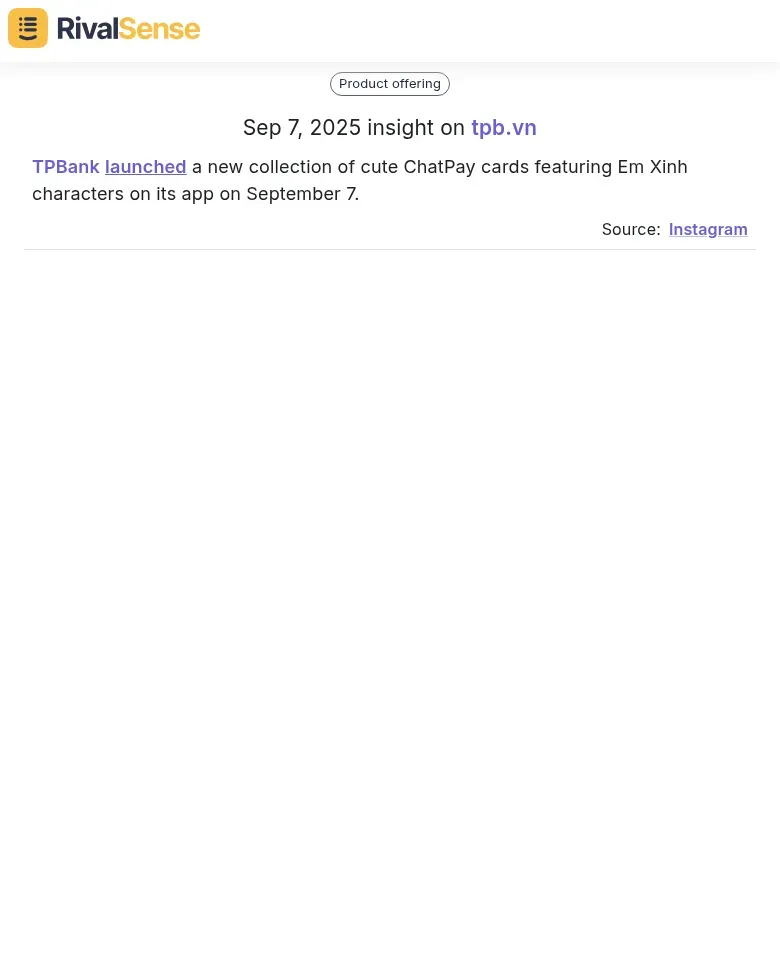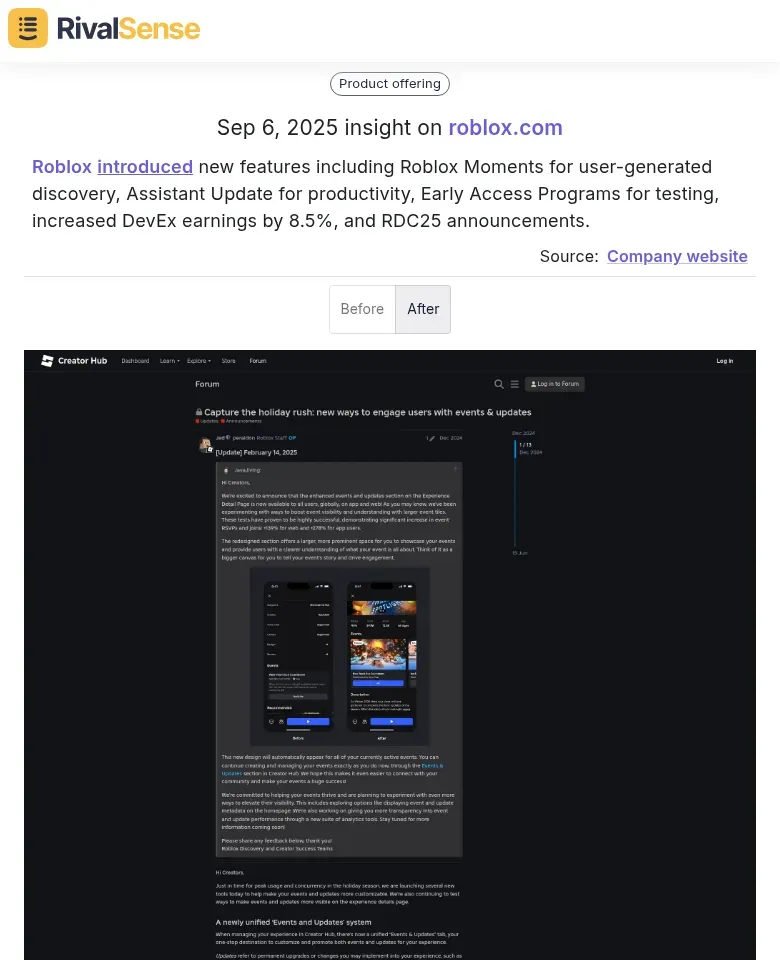Advanced Tactics: Uncover Competitor Product Secrets via Backlink Analysis
Introduction: The Power of Backlink Analysis for Competitive Intelligence
Backlinks are more than just SEO signals—they're digital footprints that reveal your competitors' strategic moves in real-time. Every link pointing to a competitor's site tells a story: new product launches, content partnerships, media coverage, or emerging market positioning. By analyzing these patterns, you gain unprecedented insight into what your rivals are building, promoting, and prioritizing.
Real-World Example: When TPBank launched a new collection of cute ChatPay cards featuring Em Xinh characters, backlink analysis would have revealed this product launch through links from fintech blogs and lifestyle publications. Tracking such product launches helps you understand competitor positioning and identify market opportunities.

Practical tip: Use tools like Ahrefs or Semrush to set up backlink alerts for competitor domains. When you notice sudden spikes in new referring domains, investigate the sources—these often indicate product launches, major announcements, or successful PR campaigns. Track anchor text variations to uncover keyword strategies and content themes they're targeting.
The strategic advantage? You'll identify partnership opportunities before they become saturated, anticipate market shifts, and position your offerings to counter emerging threats. Backlink analysis transforms reactive competition into proactive market intelligence.
Methodology: How to Extract Product Insights from Competitor Backlinks
To extract product insights from competitor backlinks, start by monitoring backlink acquisition patterns. Use tools like Ahrefs or SEMrush to track sudden spikes in new backlinks—these often signal product launches. For example, a 200% increase in backlinks over a week could indicate a major release.
Real-World Example: When Roblox introduced multiple new features including Roblox Moments, Assistant updates, and Early Access Programs, backlink analysis would have detected this through links from gaming publications, developer communities, and tech blogs. Monitoring feature updates helps you stay ahead of competitor innovation cycles.

Analyze anchor text context to understand feature updates. Look for keywords like "new integration" or "enhanced functionality" in linking pages. If competitors receive links with anchor text like "AI-powered analytics," they likely launched AI features.
Track backlink sources to uncover partnerships. Links from tech blogs or integration platforms (e.g., Zapier) suggest new collaborations. Create a checklist: 1) Set up alerts for competitor domain backlinks, 2) Filter by date to detect spikes, 3) Review anchor text for product-related terms, 4) Identify high-authority linking domains for partnership clues.
Practical tip: Use SEMrush's Backlink Analytics to automate this process and receive weekly reports.
Case Study Insights: Learning from Real-World Backlink Patterns
Limited edition product launches create buzz that generates niche backlinks from enthusiast blogs and industry influencers. For example, when a tech company launched a collector's edition device, we observed backlinks from 15+ niche gadget review sites within 72 hours.
Feature rollouts are detectable through developer community links. Monitor platforms like GitHub, Stack Overflow, and tech blogs for new API documentation links or technical tutorials. When a SaaS competitor released a new integration, 8 developer blogs linked to their documentation within the first week.
Financial and partnership developments appear through industry-specific backlinks. Watch for links from financial news sites, partnership announcements on corporate blogs, and industry association websites. One fintech client identified a competitor's new banking partnership through backlinks from 3 financial industry publications.
Practical Checklist:
- Set up alerts for competitor domain mentions on tech blogs and developer platforms
- Monitor industry-specific news sites for partnership announcements
- Track backlink velocity spikes around product launch dates
- Analyze anchor text patterns for feature-specific terminology
- Use tools like Ahrefs or Semrush for comprehensive backlink analysis
Advanced Techniques: Beyond Basic Backlink Monitoring
Move beyond simple backlink counting with these advanced tactics that reveal competitor product secrets:
Backlink Velocity Analysis for Market Prediction
Track competitor backlink growth rates to anticipate product launches. A sudden spike in high-authority links often precedes major announcements. Use Ahrefs' Referring Domains → New & Lost feature to monitor monthly growth patterns. When you see a 200%+ velocity increase from industry publications, prepare for competitor feature releases within 30-60 days.
Semantic Analysis of Linking Content
Analyze the context around competitor backlinks using tools like MarketMuse. Look for recurring semantic patterns: mentions of "integration," "API," or specific feature names indicate upcoming developments. For example, multiple links discussing "AI-powered analytics" likely signal a machine learning product expansion.
Cross-Platform Correlation Intelligence
Correlate backlink patterns with social media mentions and news coverage. Set up monitoring to track:
- Backlink spikes coinciding with LinkedIn product announcements
- News site coverage that references the same features as recent backlinks
- Reddit discussions that mirror the semantic themes found in linking content
Real-World Example: When Airbnb started exploring stablecoin integrations, backlink analysis combined with financial news monitoring would have provided early signals of this strategic move. Tracking financial and regulatory developments helps you anticipate market shifts and competitor positioning.

Practical Implementation Checklist:
- Monitor top 3 competitors' backlink velocity weekly using Ahrefs/Semrush
- Export linking page content and run semantic analysis quarterly
- Set up alerts for 50%+ velocity increases from DR80+ domains
- Cross-reference findings with social listening tools monthly
- Document patterns in a competitive intelligence dashboard
This multi-dimensional approach transforms backlinks from SEO metrics into strategic product intelligence, giving you 2-3 month lead time on competitor movements.
Actionable Strategies: Turning Backlink Insights into Competitive Advantage
Transform backlink analysis into a strategic early warning system by monitoring competitor link acquisition patterns. When competitors suddenly gain links from tech blogs or industry publications, it often signals upcoming product launches. Set up automated alerts for new backlinks to high-authority domains in your space—this gives you 2-4 weeks' advance notice of major announcements.
For targeted outreach, analyze competitor partnership patterns through their backlink profiles. Identify which publishers, influencers, and complementary businesses consistently link to them. Create a prioritized outreach list targeting these same relationships, but with a unique value proposition. Example: If a competitor gets links from SaaS review sites, develop superior integration documentation to become the preferred reference.
Build defensive strategies by anticipating competitor moves through link velocity analysis. Track when competitors accelerate link building—this often precedes market expansions or feature releases. Create counter-content preemptively: if they're building links around "AI integration," develop deeper educational content on the topic before their launch.
Implement a monthly backlink audit checklist:
- Identify new competitor links
- Categorize by domain authority and relevance
- Assess threat level
- Develop response strategy
Tools and Implementation: Building Your Competitor Backlink Intelligence System
Building an effective competitor backlink intelligence system requires strategic tool selection and integration. Start with industry-standard tools like Semrush, Ahrefs, or SpyFu for comprehensive backlink analysis—these platforms provide detailed competitor link profiles, domain authority metrics, and gap analysis capabilities. For automated monitoring, set up real-time alerts in tools like Semrush's Position Tracking or Ahrefs Alerts to receive instant notifications when competitors gain new backlinks or change their linking strategies.
Create a centralized dashboard by integrating backlink data with other competitive intelligence sources. Combine SEO data with social listening tools (like BuzzSumo), pricing intelligence platforms, and web analytics to create holistic competitor profiles. Use API integrations to automate data flow between systems, ensuring your team has access to real-time, cross-channel insights.
Implementation checklist:
- Identify 3-5 key competitors using keyword overlap analysis
- Set up weekly automated reports for new competitor backlinks
- Create alert thresholds for significant link acquisitions (e.g., +10% domain authority)
- Integrate backlink data with CRM systems for sales intelligence
- Establish monthly review cycles to identify emerging linking patterns and opportunities
Putting It All Together: Streamlining Competitive Intelligence
While manual backlink analysis provides valuable insights, the process can be time-consuming and complex. This is where specialized competitive intelligence tools like RivalSense can make a significant difference. RivalSense automatically tracks competitor movements across multiple channels—including product launches, pricing updates, partnerships, and media mentions—delivering consolidated weekly reports directly to your inbox.
Ready to transform your competitive intelligence strategy? Try RivalSense for free and get your first competitor report today to start uncovering hidden opportunities and threats in your market.
📚 Read more
👉 Why Tracking Competitor Executive Hires Matters: The Gigi Janelidze Case
👉 How to Do Competitor Target Audience Analysis: A Practical B2B Guide
👉 Risk Management in Key Account Strategy: A Practical Guide
👉 How Adyen Capitalized on Stripe's Blockchain Bet: A Strategic Playbook for B2B Leaders
👉 Twitter Competitor Insights: Actionable Cultural Alignment Strategies
